I wake up at 5:45 am, told to be “sin falta” at 7 at the airport. Peta asks me to feed the un-named kitty, so dripping from the shower and barely awake, I do my best to inject some soy milk into the furry beast, who easily fits in the palm of my hand. By 6am, I am in the car and by 7am I get to the airport.
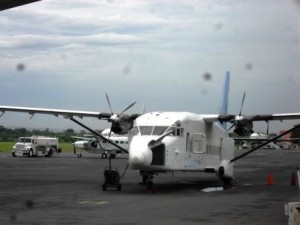 No Gustavo at the airport. Gustavo is CO2 BAMBU’s lead forester and he has organized the last minute trip to Rosita to meet with the mayor. Gustavo strolls in casually at 7:30, telling me he said 7am “just to be sure” I’d get there. I ask him to please tell me actually at what time I need to be somewhere and not try to second guess me as I would have preferred to stay in bed.
No Gustavo at the airport. Gustavo is CO2 BAMBU’s lead forester and he has organized the last minute trip to Rosita to meet with the mayor. Gustavo strolls in casually at 7:30, telling me he said 7am “just to be sure” I’d get there. I ask him to please tell me actually at what time I need to be somewhere and not try to second guess me as I would have preferred to stay in bed.
No matter, it gives me a chance to chat with the airline staff and inquire about the route. I want to know if we are going straight from Managua to Rosita. “It depends” they say. “It depends on what?” , “depends on where the passengers want to go”, I am told. OK, I can see this is going to be a “different” flying experience. It turns out that there are three destinations in RAAN (Bonanza, Siuna, Rosita) that make up the “Mining Triangle” and that, depending on the desired destination of the majority of the passenger list, the Captain decides where to go first. Who makes up the passenger list is a function of who shows up by 8, so the counter staff can’t tell me where we are going yet.
There are a few 6 – 12 seater planes on the tarmac, so I assume one of these is for our journey to Rosita. “Depends”, says the tarmac staff – we’ll see how many people are going to the other destinations and who leaves first. OK, let’s summarize: the destination is a function of passenger profile and the airplane we use is a function of who gets to leave first. Here we have our first problem. It’s 9 am and there is rumor of rain in Rosita. It’s not advisable to fly or try to land in the rain, they say, because of what happens to the landing strip in the rain. I prefer not to ask for details… So it’s now 11am and there is no apparent movement.
My current thoughts are that a) I hope we leave, b) I hope we land, c) I hope I can get back tomorrow. I have nightmarish visions of the show “Survivor”, being jetissoned somewhere in the jungle between Managua and the Triangulo de Minas, having to find my way to civilization, battling snakes, mosquitoes and who knows what other fauna. Peta insisted that I pack some food in my backpack “just in case”. Let’s hope it doesn’t become my survival pack through dense forest.
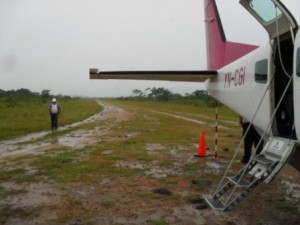 The plane is somewhat of an antique aviation collection piece. It seats (comfortably) 8 and the pilot just sits “among us”, chatting casually throughout the flight with passengers. One detail that I would have preferred NOT to have witnessed was the pilot crossing his heart (catholic ritual for “hope to get there”) before we take off. We fly high enough to miss the mountain tops, but not by much. Things get sporty when we get to Bonanza. We start to land and all of the sudden the plane makes a steep (accent on stEEEEp climb).
The plane is somewhat of an antique aviation collection piece. It seats (comfortably) 8 and the pilot just sits “among us”, chatting casually throughout the flight with passengers. One detail that I would have preferred NOT to have witnessed was the pilot crossing his heart (catholic ritual for “hope to get there”) before we take off. We fly high enough to miss the mountain tops, but not by much. Things get sporty when we get to Bonanza. We start to land and all of the sudden the plane makes a steep (accent on stEEEEp climb).
Why? Because there are horses on the runway. Runway of course is a relative term. 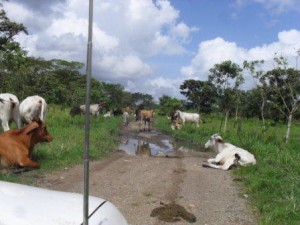 Let’s say it’s a dirt strip unprotected by any fencing, so it’s a game of chicken between horses, cows and any plane that wants to land. But we eventually land in the rain. Four people get out, and two skimpily clad local women get in. I am told that female companionship is a booming business in the gold mining towns and they make up a sizeable portion of the flying population between the three towns of the mining triangle.
Let’s say it’s a dirt strip unprotected by any fencing, so it’s a game of chicken between horses, cows and any plane that wants to land. But we eventually land in the rain. Four people get out, and two skimpily clad local women get in. I am told that female companionship is a booming business in the gold mining towns and they make up a sizeable portion of the flying population between the three towns of the mining triangle.
We do finally make it to Rosita’s “air strip”. No horses this time. One broken down taxi that the plane narrowly misses at the end of the runway. On the way into town, I find out that yesterday was such a good fiesta, that the mayor declared it a holiday today for all government workers. Nice. Since I came here precisely to meet the Mayor, this means I came for nothing. “Tranquilo” says Gustavo, we’ll meet the mayor…
Gustavo is hungry. While I appreciate his state, I’d rather he focus on finding the mayor. “Tranquilo” he repeats as he orders a chicken “a la plancha” at a nearby dive. Turns out the owner is a friend of the mayor and Gustavo explains that his boss is here and that I’m going to Ecuador tomorrow and that I must meet the Mayor. With perfect timing, as Gustavo finishes his chicken, the Mayor arrives at the lunch place. We discuss bamboo housing and he tells me that they are working with the Spanish for a 300 home project and that I could come back in 2 weeks and make a presentation to the committee.
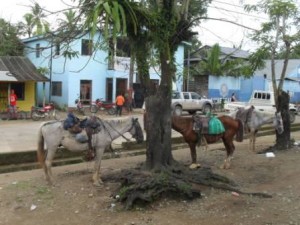
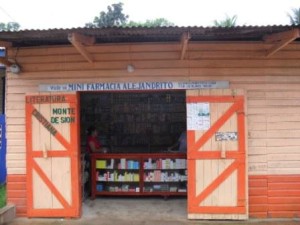 After the meeting with the mayor, I take a stroll down the main street, scratch that, the ONLY street in town. It is just like a Twilight Zone episode: I’ve been transported to a cowboy or gold mining town, circa 1870. Every one-floor shack sells basic survival equipment (rope, flashlights, boots, barbed wire, picks and shovels, saddles and spurs…).
After the meeting with the mayor, I take a stroll down the main street, scratch that, the ONLY street in town. It is just like a Twilight Zone episode: I’ve been transported to a cowboy or gold mining town, circa 1870. Every one-floor shack sells basic survival equipment (rope, flashlights, boots, barbed wire, picks and shovels, saddles and spurs…). 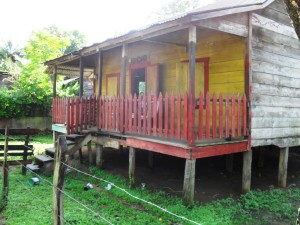 There are cooking stoves right on the street cooking the same gallo pinto. Men wear guns.
There are cooking stoves right on the street cooking the same gallo pinto. Men wear guns. 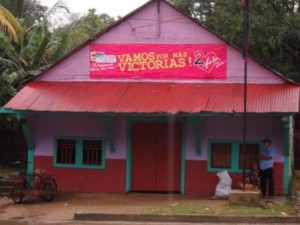 There are several gambling parlors with slot machines. The only store in town with a robust front (in stone) is the Western Union office. There is a pharmacy and a doctor’s office. There are multiple reminders that this is a Sandinista town.
There are several gambling parlors with slot machines. The only store in town with a robust front (in stone) is the Western Union office. There is a pharmacy and a doctor’s office. There are multiple reminders that this is a Sandinista town.
My next stop is an impromptu call on a HUGE Soviet Era type industrial complex in the middle of nowhere. 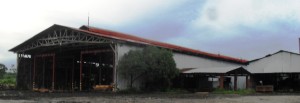 They make plywood from large just logged trees. No appointment. No-one at the guard station. “Tranquilo” says Gustavo as he talks to the 80 year old man who slowly makes his way toward the gate. He talks, the guy shakes his head. He gesticulates, the guy continues to shake his head. The outcome is that Lesbia, the woman in charge of the place, does not have me on her agenda and its 5 pm, the place is closed. “Tranquilo” says Gustavo as he explains that she lives on the premises. More cajoeling and the guard eventually goes and checks on Lesbia, who grants us an audience. She comes out of her house, in tight white stretch pants with a plunging neckline that, believe me, she ought to hide. Her hair is waist long and Gustavo and the forester we have picked up along the way (not sure why) are just falling over themselves, bright red at the sight of this woman. We meet in her Spartan office and I explain that I am looking for a local partner to kickstart a bamboo production line for local housing production. She is smart as a whip and leads us through her business model (can’t compete with the Chinese, but does with the Guatemalans), opines on the local meskito communities (lazy), waxes nostalgically about the good old days (there used to be 1000 employees, now 97) and tells me she had plans to build 50 houses on “her” land, maybe they should be in bamboo. She then takes us on a tour of her plant, now shut down, and I discover millions of dollars of wood processing equipment under an aging roof. Turns out they have this massive carrot peeler which just might peel bamboo and put us in the category of bamboo plywood producers, which is a huge market category. There are ovens, large presses, no shortage of equipment, plenty of space, and an organization in place. Oh, and they are located downstream from a river that flows from where the current bamboo lies, so the transportation challenge (given the few roads) is solved.
They make plywood from large just logged trees. No appointment. No-one at the guard station. “Tranquilo” says Gustavo as he talks to the 80 year old man who slowly makes his way toward the gate. He talks, the guy shakes his head. He gesticulates, the guy continues to shake his head. The outcome is that Lesbia, the woman in charge of the place, does not have me on her agenda and its 5 pm, the place is closed. “Tranquilo” says Gustavo as he explains that she lives on the premises. More cajoeling and the guard eventually goes and checks on Lesbia, who grants us an audience. She comes out of her house, in tight white stretch pants with a plunging neckline that, believe me, she ought to hide. Her hair is waist long and Gustavo and the forester we have picked up along the way (not sure why) are just falling over themselves, bright red at the sight of this woman. We meet in her Spartan office and I explain that I am looking for a local partner to kickstart a bamboo production line for local housing production. She is smart as a whip and leads us through her business model (can’t compete with the Chinese, but does with the Guatemalans), opines on the local meskito communities (lazy), waxes nostalgically about the good old days (there used to be 1000 employees, now 97) and tells me she had plans to build 50 houses on “her” land, maybe they should be in bamboo. She then takes us on a tour of her plant, now shut down, and I discover millions of dollars of wood processing equipment under an aging roof. Turns out they have this massive carrot peeler which just might peel bamboo and put us in the category of bamboo plywood producers, which is a huge market category. There are ovens, large presses, no shortage of equipment, plenty of space, and an organization in place. Oh, and they are located downstream from a river that flows from where the current bamboo lies, so the transportation challenge (given the few roads) is solved.
I write this blog entry at 2:30 am. It seems the local roosters are on Tokyo time as it is pitch dark and yet there is a symphony of wake up calls. The bed is hard and I am starting to fret about the return trip. More importantly, I am starting to fret that this may be CO2 BAMBU’s next area of focus for reforestation, bamboo house production and perhaps bamboo plywood exports. The thought of coming here regularly does not seem so attractive, but then again, there IS bamboo here.
fasncinating contrasts the way business is conducted in s.america vs the way business was conducted in the US